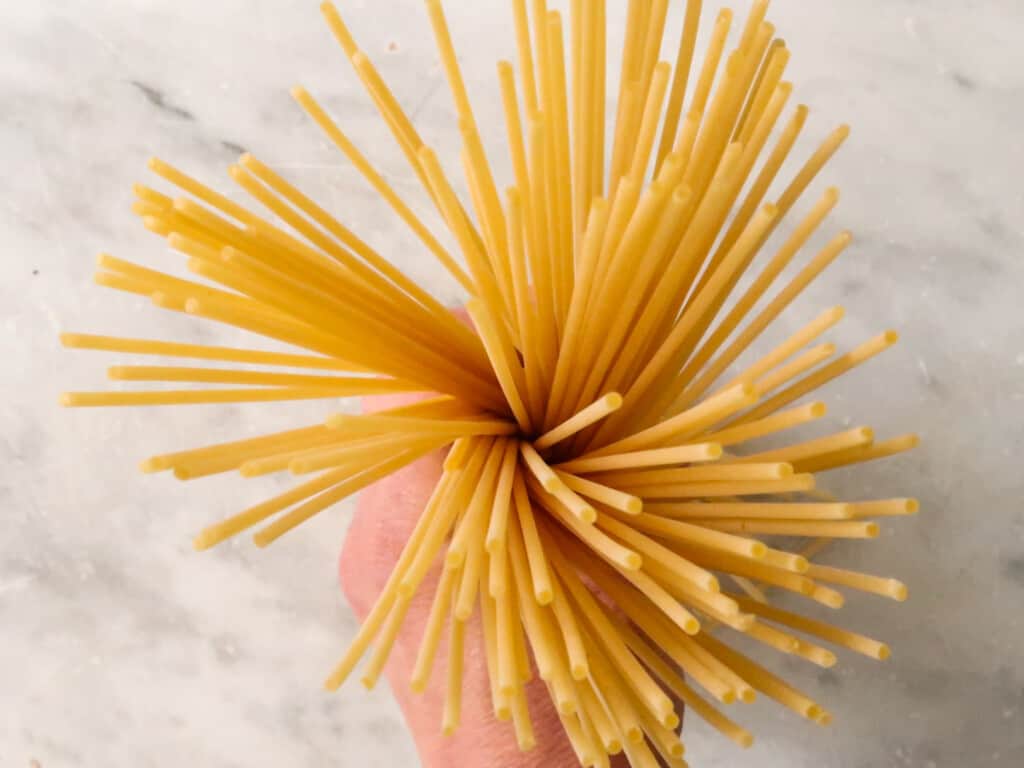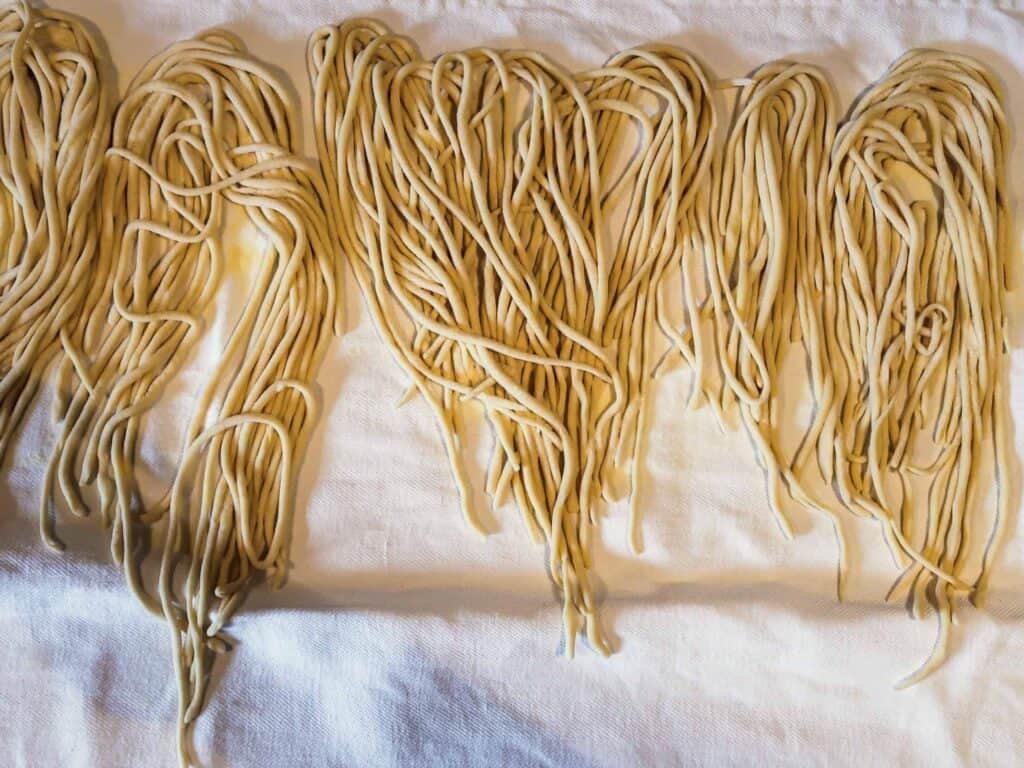Last updated on April 19th, 2024
Did you know there are around 1,000 different kinds of cured meats and Italian sausages made in Italy?!
You may need some help trying to figure out which one to try next.
If you are curious about the different types of Italian sausage, their origins, and their pronunciations – you’re in the right place!
Our family loves to eat our local Tuscan sausages, and we also try sausages in other Italian regions when we’re traveling.
In this article, I will cover the most beloved and popular types of Italian sausage, including where to find them and eat them in Italy.
Note: Because there are so many Italian sausages, many of which are only produced on a very small scale regionally, I am only speaking to the most popular and/or widespread varieties of Italian dried sausage.
Jump to Section
How To Say Sausage In Italian
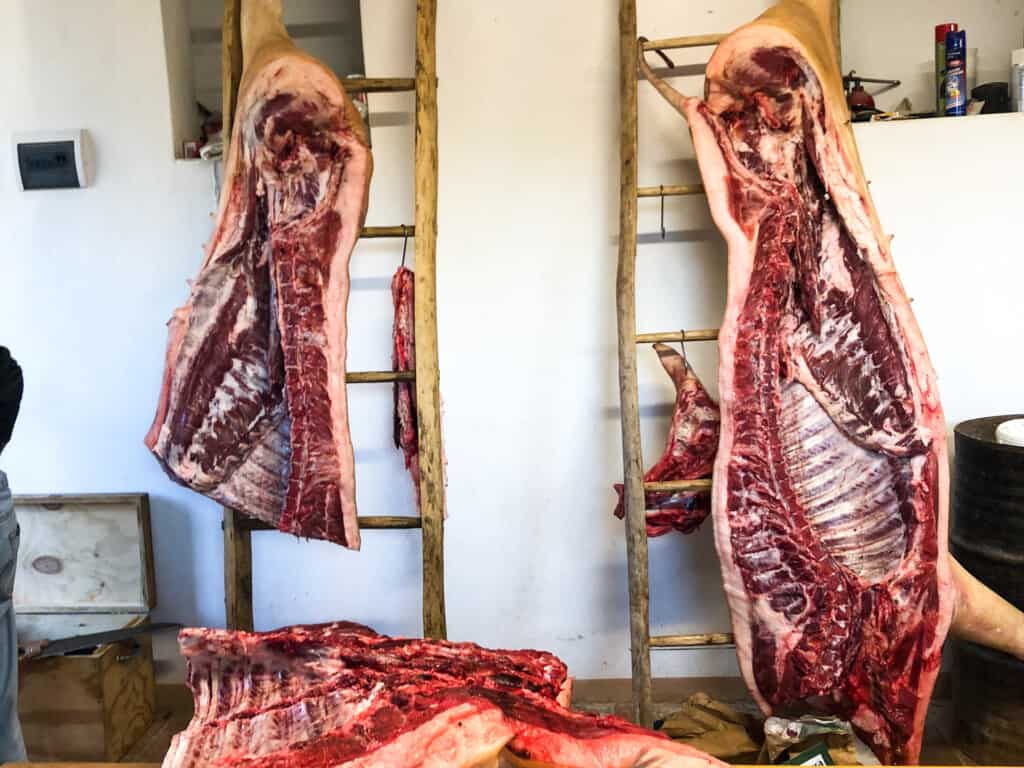
Sausage in Italian is salsiccia, pronounced sahl-seech-chah.
Listen to the pronunciation of salsiccia:
Dried sausage in Italian is salsiccia secca, pronounced sahl-seech-chah sehk-kah.
Listen to the pronunciation of salsiccia secca:
What Is Italian Sausage?
Italian sausage is usually made from pork that is seasoned with salt, pepper and various herbs and spices before being stuffed into a natural casing.
Insaccati – Fresh Italian Sausage

Italian sausage that is not fermented and meant to be cooked in a relatively short amount of time is considered fresh and known as insaccati in Italian. Within insaccati, there is salsicce (typical fresh sausages) and cotechini (fresh sausage with the pork rind and skin mixed into the meat).
Salame – Dried Italian Sausage
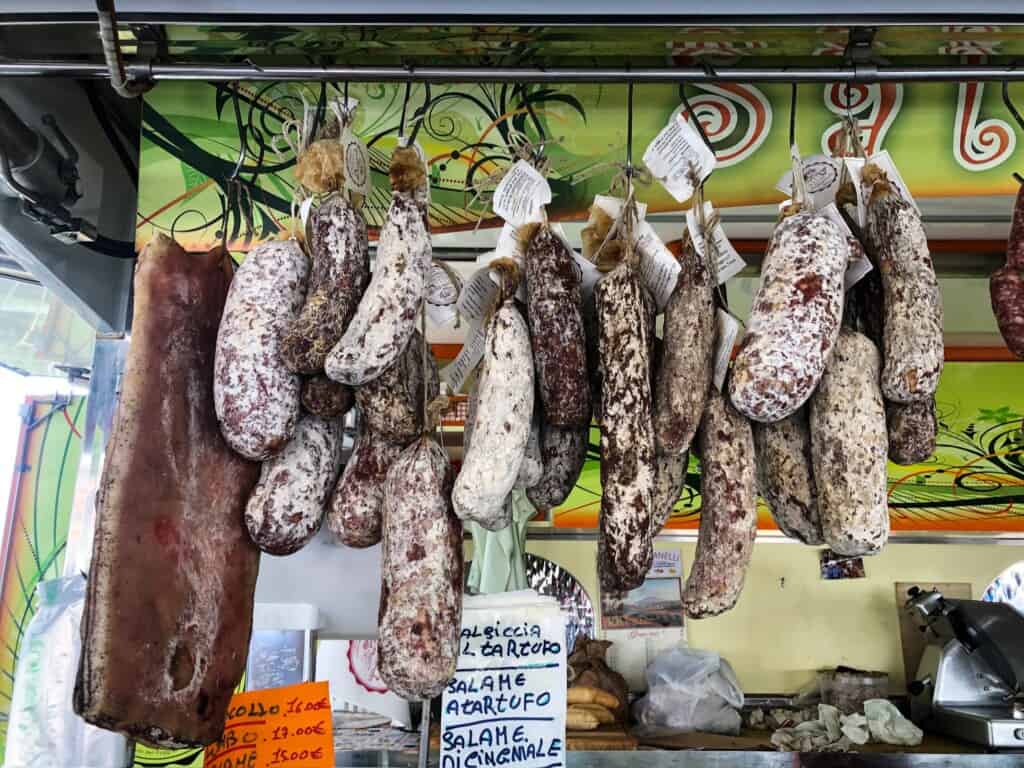
Dried Italian sausage, known as salame (plural: salami), in Italian, means that it has been cured (fermented), or preserved in salt and dried for an extended time to increase its shelf life.
Fact: Although the technical term for dried Italian sausage is salame, it’s often referred to as salsiccia secca, dried sausage in many regions.
Historically, dried Italian sausage has been crucial to the Italian diet as it provided them the ability to store meat for long periods without going rancid.
Difference Between Cured Meats And Italian Sausage

Cured meats are meats that have been salted and aged by means to preserve it for long storage. Italian sausage can be considered a type of cured meat if aged. If it’s fresh and needs to be cooked, it’s not considered a cured meat.
Difference Between Italian Sausage In America and Italian Sausage in Italy
Italian sausage in America refers to a category of fresh sausage made typically from pork, seasoned with various spices and flavorings. The most common varieties of Italian sausages in America are mild, spicy and sweet, which are classified by their seasonings and level of spice.
Italian sausage in Italy refers to meat that is seasoned with spices, herbs, salt and/or pepper and packed into a natural casing. Types of Italian sausage can either be fresh or dried.
How To Eat Italian Sausage

In Italy, various types of Italian sausage are enjoyed at really any given time of the day, especially in sandwiches, as an antipasto or appetizer or with cocktails or a glass of wine for an aperitivo.
Every Italian region is proud of the local types of Italian sausage which you will likely be able to try in an antipasto misto or mixed appetizer at any restaurant. You can also find them served in a tagliere di affettati or charcuterie board.
Italian sausages are also a popular item to add to sandwiches in Italy. Usually they don’t mix different types of Italian sausage in one sandwich like you might find in an Italian sub in America.
Certified PDO and PGI Italian Sausages

Of all the Italian sausages on the market, only 20 have been awarded either a PDO or PGI certificate. This certification is given only to products that have been produced and packaged in accordance with strict guidelines of production from the initial raising of the animals to the finished product, conducted in a specific geographical location within Italy.
Fact: DOP and PGI Italian food products can be shipped and sold anywhere. They do not have to be sold in the same geographical region from which they originated.
- The certification PDO (Protected Designation of Origin) is given to products that originate in a specific place and adhere to specific phases of production that follow strict regulations (DOP in Italian).
- The certification PGI (Protected Geographical Indication) is given to products that originate in a specific place. Only one of the production steps must take place in this same geographical area according to looser guidelines (IGP in Italian).
For example, anyone can make salame piemonte but unless it’s produced within Piedmont according to the original recipe and traditional practice of aging, it cannot by law be called salame piemonte.
Certified PDO and PGI Italian Sausage Names
Ciauscolo PGI
From Le Marche, ciauscolo is characterized by its smooth texture that is spread like butter instead of being sliced like other cured sausages. The high fat content and very fine mince creates a buttery texture, ideal for enjoying on bread.
Cotechino Modena PGI

Cotechino is an Italian sausage made with a large amount of pork skin, making for a very pink colored meat. The cylindrical sausage is cooked, sliced and often served with lentils for Christmas or the New Year. It has a firm, even texture with a very unique taste (from the skin added to the sausage).
Fact: There are many types of cotechino but the Modena one is held to stricter regulations of production.
Finocchiona PGI

Finocchiona is a Tuscan salame made from finely ground pork trimmings flavored with lots of garlic, pepper and fennel seeds. The salame is dotted with white bits of fat, fennel seeds and characterized by its bright pink interior.
Lucanica di Picerno PGI
Lucanica sausage from Basilicata is characterized by the ‘U’ shape made to hang it on special racks as it matures. It’s flavored with black pepper, local chili peppers and wild fennel, making it quite complex and flavorful.
Mortadella Bologna PGI

Mortadella Bologna is Italy’s version of bologna meat made from pork meat and fat that is stuffed into natural or synthetic casings, sometimes flavored with black pepper or pistachio, and slow cooked. The mortadella from Bologna is the best in the world and goes through strict, rigorous production laws, ensuring top quality every time.
Mortadella di Prato PGI
Mortadella di Prato is another type of cooked Italian sausage flavored with various spices and alchermes liqueur (infused with cinnamon and cloves and citrus), creating a dark pink interior. The texture is firm, making it ideal for slicing.
Salama da Sugo PGI
Salama da sugo is a pork sausage from Ferrara in Emilia-Romagna, sold already cured or fresh, packed in a natural pig bladder. Because of all the natural gelatine from the pig, the texture is soft and crumbly.
Salame Brianza PDO
Salame Brianza is a cured Italian sausage produced only in Lombardy, Emilia-Romagna and Piedmont where the climate is ideal for growing herbs used to flavor this regional specialty. The flavor is mild, with a bright ruby-red interior.
Salame Cremona PGI
Salame Cremona is made in Lombardy, Emilia Romagna, Piedmont and Veneto from the Large White, Landrace, and Duroc breed of pigs. Salame Cremona is mildly spicy, typically served in an antipasto misto (mixed appetizer platter).
Salame di Varzi PDO
Salame di Varzi is an ancient Italian sausage dating back to The Middle Ages. Characterized by a dark red color with large bits of fat with a slightly sweet flavor, this Italian sausage is cured anywhere from 45-80 days.
Salame d’oca di Mortara PGI
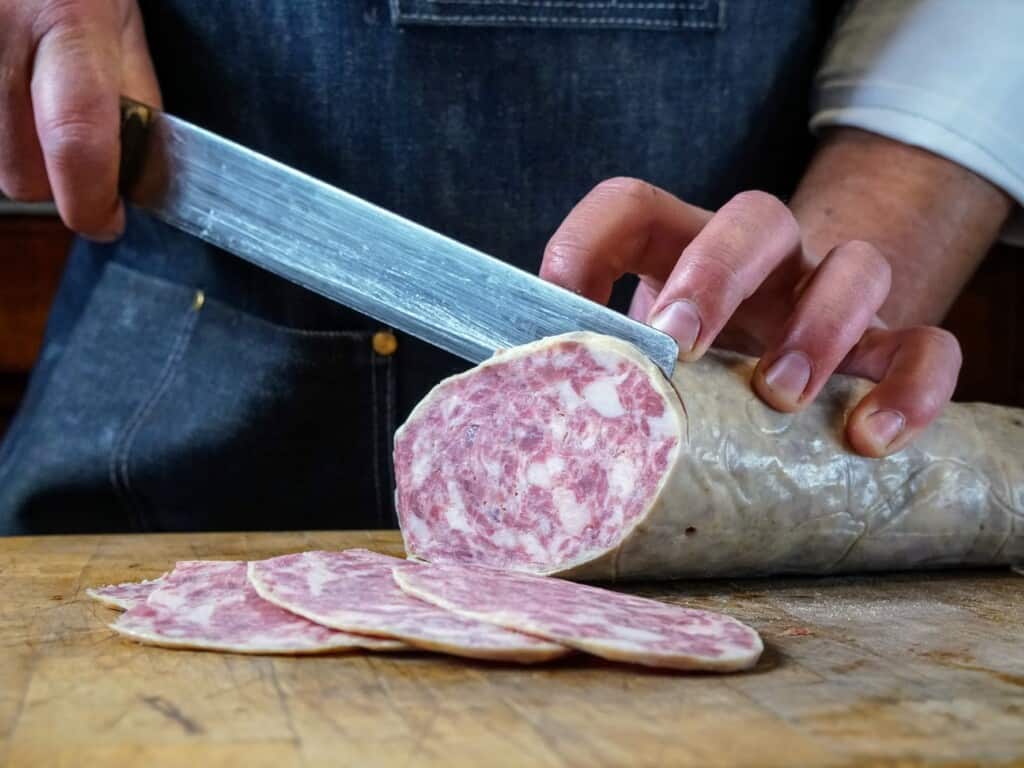
Salame d’oca is a delicate goose sausage flavored with light spices from Lombardy dating back to the jewish communities in the 15th century.
Salame Felino PGI
Salame Felino is made in Parma, which has the ideal landscape and climate for cured meat production. This kind of cured salame can only be made with specific pig breeds and is held to high standards of production.
Salame Piacentino PDO
Salame Piacentino is a cured Italian sausage from Piacenza in Emilia-Romagna, characterized by its bright red color, large chunks of white fat and sweet, intense aroma.
Salame Piemonte PGI
Salame Piemonte is a soft, sweet cured sausage with a short maturation period. What sets this Italian sausage apart is the fact that it’s flavored with strictly Nebbiolo, Barbera, and Dolcetto wine varieties.
Salame S. Angelo PGI
Salame S. Angelo from Sicily is set apart by its irregular, cylindrical shape, covered in white mold and flavored with spices. The interior is dark red with white fat pieces.
Salamini Italiani alla Cacciatore PDO

Salamini Italiani alla cacciatore are small, short Italian sausages with a firm, compact texture. The sausage is well balanced between flesh and fat with a bright red interior. Its name alla cacciatore means ‘hunter-style’ and refers to when hunters would pack these small, short cured sausages into their bag for long days out in the woods in search of a good day’s hunt.
Salsiccia di Calabria PDO
Salsiccia di Calabria is a typical aged sausage from southern Italy shaped into a ‘U’ or horseshoe. Salsiccia di Calabria is made from both lean pork shoulder meat and fatty bacon that are then seasoned with spices and pepper. It may also have spicy chilli peppers. This Italian sausage comes in three types: bianca (without chili peppers), dolce (with sweet chili peppers) or piccante (made with hot chili peppers).
Soppressata di Calabria PDO

Also known as suppizzata, soppressata di Calabria is a cured sausage made from both lean pork and fat flavored with spicy chili and fennel, giving it a dark red, almost orange color. It can be identified by its slightly flattened cylindrical shape.
Soprèssa Vicentina PDO
Soprèssa Vicentina from Veneto is one of the best Italian sausages from the north, using only the best cuts of pork to make this delicate, sweet yet peppery sausage. It’s very fatty and buttery, perfect with a glass of dry white wine as an aperitivo.
Zampone Modena PGI
Zampone is one of the most interesting Italian sausages out there made from meat ‘paste’ that is stuffed into a natural casing of the pig’s foot, complete with the hoof. Italians either love or hate the zampone but when they love it, they go crazy for it!
Names Of Italian Sausage
Below you will find the most popular types of Italian sausages with their geographical location, description and pronunciation.
Salsiccia Fresca

(Pronounced sahl-seech-chah freh-skah in Italian)
More than a name, salsiccia fresca, is more of a category of fresh pork sausage meant to be cooked in a relatively short amount of time from its production. When you go to a butcher in Italy, locally made fresh sausage will be sold by the kilo. Many regions have their own varieties but in general, you will always find what Italians call salsiccia fresca available at any supermarket or butcher.
Usually they are grilled or pan seared and steamed in wine, served with grilled vegetables, polenta, white beans), roasted potatoes and other local contorni (side dishes).
Cook With It: Try my recipe for 3-Ingredient Pappardelle Boscaiola.
Salame
(Pronounced sah-lah-meh in Italian)
Salame is a general term for cured Italian sausage that is fermented and then air dried, allowing it to be stored at room temperature for years. A popular variety is salame genovese di Sant’Olcese made from a combination of pork, beef and/or veel, red wine, garlic and spices. The texture is soft while the flavor is rich and pronounced. My family likes to eat this salame in sandwiches.
Types Of Salami
There are so many varieties of salami in Italy, each neighborhood and family with their own recipe. Here are some of the most popular to try in Italy:
- Salame di Fabriano
- Salame Calabrese
- Salame di Verona
- Salame genovese
- Salame milanese
- Salame di Sorrento
- Salame di Napoli
Fact: Remember, salame is the singular form of salami.
Salame Napoli
(Pronounced sah-lah-meh nah-poh-lee in Italian)
Salame Napoli is an Italian salame made in various sizes throughout Campania. Made from pork shoulder, leg, neck, loin, and ham, black pepper, and spices, it’s then stuffed into a natural pig intestine casing, and it’s then aged for a maximum of 30 days according to its size. The salame has a firm and dense texture, great on pizza or as is on a charcuterie board.
Salamella
(Pronounced sah-lah-mehl-lah in Italian)
Salamella, known as salsiza by the locals, is a fresh pork sausage flavored with lard, spices and wine, most typically found in northern Italy in Lombardy and Trentino-Alto Adige. It usually comes in one large, thin sausage that is coiled into a circle and then cut up once cooked.
Luganega

(Pronounced loo-gah-neh-gah in Italian)
Luganega is a mild type of long, fresh Italian sausage most popular in northern Italian cuisine. It’s often referred to as salsiccia a metro or sausage by the meter’ because it’s made into one long strand that is then coiled up and sold in smaller lengths. They are best enjoyed freshly grilled.
Soppressata
(Pronounced sohp-prehs-sah-tah in Italian)
Soppressata is one of Italy’s most widespread sausages both uncured and cured. It’s usually made from undesired cuts of pork and fat before being pressed down into a natural casing. It’s then hung to age in southern regions such as Basilicata, Puglia and Calabria.
In Tuscany, the soppressata is defined with the addition of offal. This sausage is made from pork or beef. These versions are preserved and must be packed in olive oil once opened.
Fact: You will never find two soppressate the same as every butcher has his or her own recipe. Some add citrus and ginger, others are more traditional and add hot peppers and plenty of garlic.
‘Nduja

(Pronounced nndoy-yah in Italian)
‘Nduja is a soft, spreadable sausage from Calabria characterized by the addition of roasted red peppers, giving it a bright red color. This Italian sausage is used in almost every dish in the regional cooking of Calabria but is also popular on pizza throughout all of Italy.
Try it on grilled bread, with fresh cheeses such as ricotta or burrata or stir it into pastas.
Strolghino
(Pronounced strohl-gee-noh in Italian)
Strolghino is a salame from Parma made from good quality cuts of lean pork and flavored with spices before being stuffed into a natural pork casing and cured for a short period. This is considered one of the higher quality Italian sausages.
Pisto
(Pronounced pee-stoh in Italian)
Originally from Mantua in Lombardy, this is a similar Italian sausage to cotechino, created in the same manner as a means to preserve every last bit of a pig after it was butchered. It’s a very soft sausage flavored with wine and pancetta, best enjoyed cooked and served with polenta.
Pitina
(Pronounced pee-tee-nah in Italian)
Pinita is a smoked Italian sausage from Friuli-Venezia Giulia flavored with garlic, red wine and local mountain herbs. The meat is rolled in corn flour before being smoked with juniper wood and aged.
Mazzafegato

(Pronounced mahz-zah-feh-gah-toh in Italian)
Mazzafegato is a small, short dry-cured sausage from Umbria made from pork liver and meat, flavored with wild fennel. There is a dolce version (sweet) seasoned with pine nuts, raisins, orange peel and sugar.
Its name comes from ammazza fegato, meaning to kill the liver, referring to the pungent and very strong flavor of this Italian sausage.
Ventricina
(Pronounced vehn-tree-chee-nah in Italian)
Ventricina is an Italian cured sausage, produced in the regions of Abruzzo and Molise on the eastern coast of the peninsula. There are two kinds: ventricina del vastese and ventricina Teramana. Ventricina del vastese is a hard, cured sausage that is thickly sliced and served with bread while ventricina Teramana is a soft, spreadable kind made with more fat, best enjoyed spread onto bread as an aperitivo.
Sanguinaccio
(Pronounced sahn-gwee-nahch-chyoh in Italian)
Sanguinaccio is a sweet Italian blood sausage usually made in the winter after the annual pig slaughter. As its name suggests it’s sweet, well paired with a rich and hearty polenta.
Biroldo
(Pronounced beer-ohl-doh in Italian)
Biroldo is a very dark red blood sausage from Tuscany typically eaten in the winter like other blood sausages after the pig slaughter in December. Made with blood, heart, lungs and tong, biroldo is flavored with rich seasonings such as clove, star anise, cinnamon, nutmeg and fennel. It’s either preserved in lard or can be enjoyed fresh, most typically cooked in a pan or on a grill.
Cured Meats Not Considered Italian Sausage

There are several Italian cured meats known as salumi that are sometimes misunderstood to be sausages but they are not. Examples as follows:
- guanciale
- bresaola
- lardo
- capocollo
- speck
- prosciutto crudo
Fact: Italian processed meats are known as salumi in Italian.
Italian Sausage Names FAQ
Italian sausages refer to uncooked sausage that need to be cooked before consumption in Italy. These are called salsiccie (salsiccia singular).
Salsiccia refers to different types of fresh Italian sausage that are made from minced ground pork, fat and various spices, usually stuffed into a natural pork casing and aged or meant to be eaten fresh by cooking them relatively soon after production.



